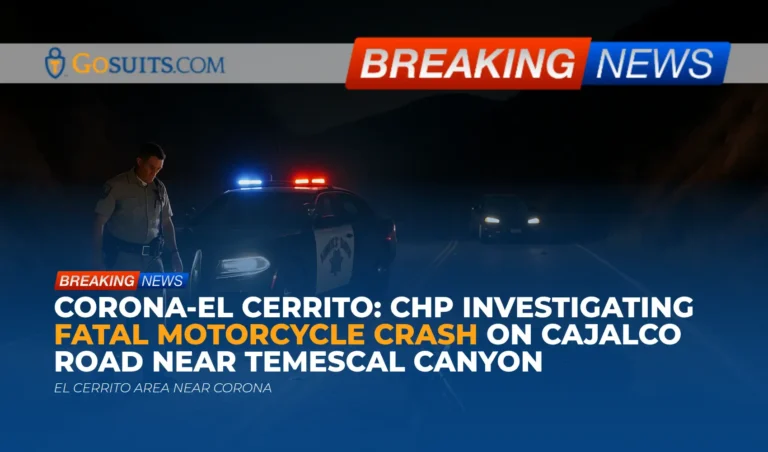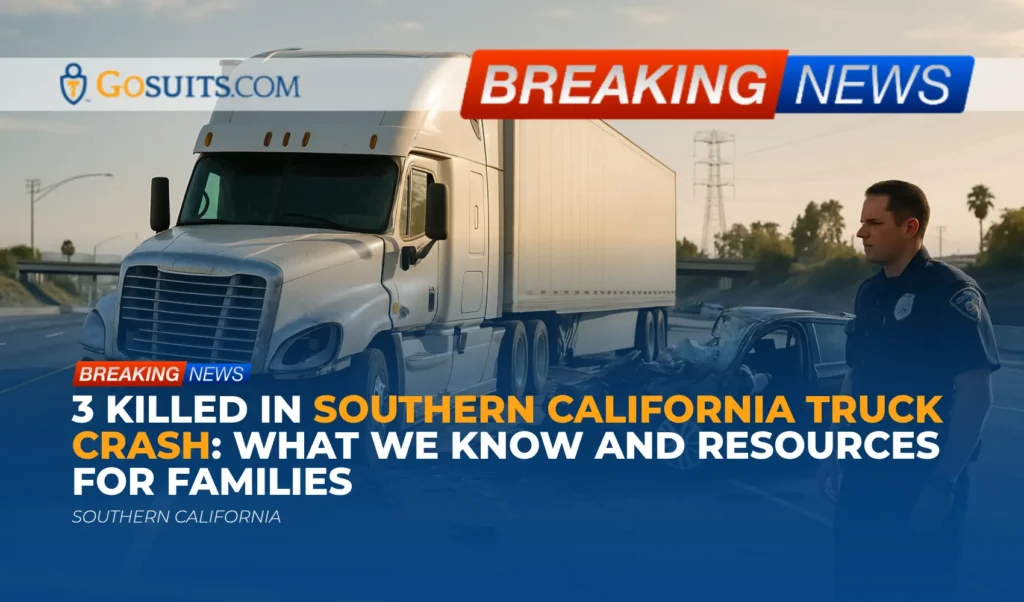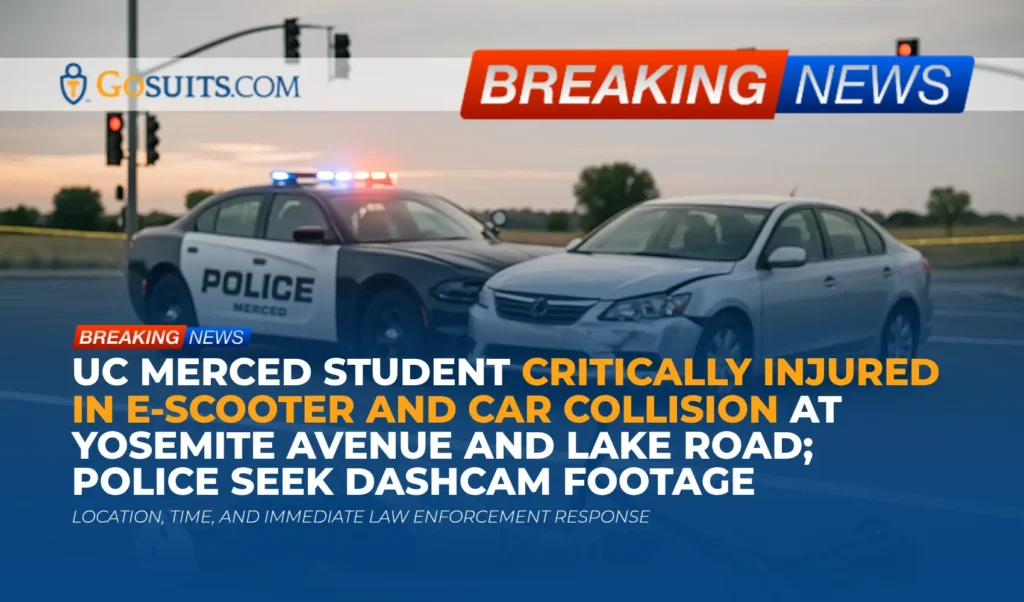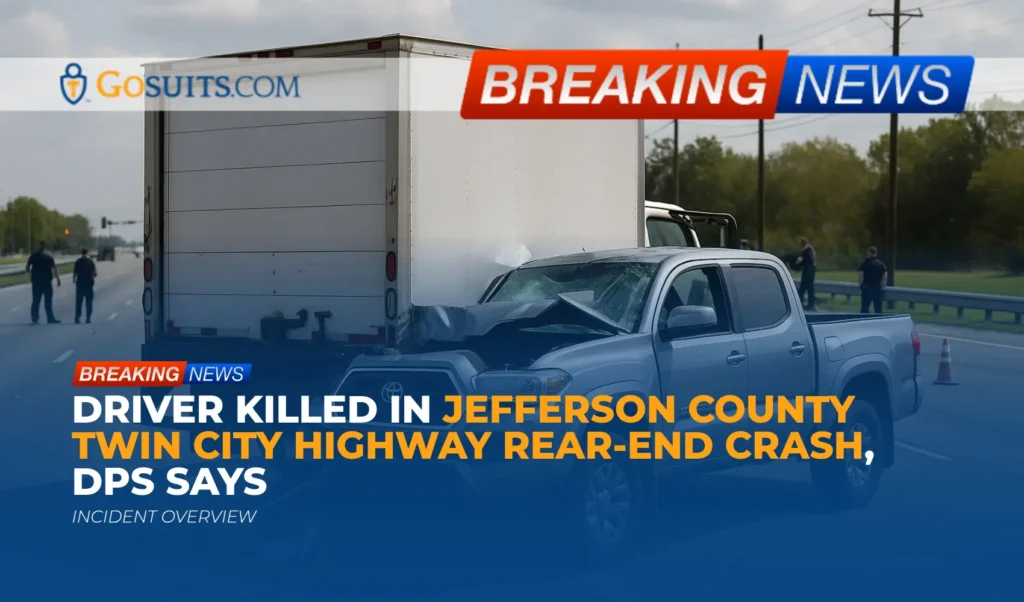- What we know about the Corona-El Cerrito motorcycle crash
- Location, time, and initial response
- Why nighttime canyon-road crashes happen
- How to obtain official records and documents
- Legal rights and potential civil liability in California
- Insurance considerations after a fatal motorcycle crash
- Evidence to preserve and investigate
- Care, grief, and practical support
- Community safety reflections and prevention
- Where to seek help and information locally
- Time-sensitive next steps and why acting soon matters
- Commentary from Gosuits Corona, California Personal Injury Attorney
What we know about the Corona-El Cerrito motorcycle crash
According to publicly available reporting, a motorcycle rider was involved in a collision with a black sedan in the El Cerrito area near Corona on Sunday evening. The California Highway Patrol received the report at approximately 8:45 p.m. The crash occurred on Cajalco Road east of Eagle Canyon Road, near Temescal Canyon Road. A witness relayed to CHP that the rider might not be breathing. There was also a report that one of the vehicles went off the roadway and descended roughly 300 feet into a canyon. In the aftermath, Cajalco Road was closed between Temescal Canyon Road and La Sierra Avenue while authorities responded and investigated.
At the time of publication, publicly shared details do not include the identity of the motorcyclist, the sedan’s driver, or a final collision cause. The initial information underscores the severity of the incident and the challenging environment along canyon corridors at night.
Location, time, and initial response
The collision was reported around 8:45 p.m., after dark, along Cajalco Road east of Eagle Canyon Road near Temescal Canyon Road in the El Cerrito area adjacent to Corona. The responding agency is the California Highway Patrol, which typically has jurisdiction over unincorporated roadways and state routes. Road closures in the area were instituted to preserve the scene, allow emergency access, and protect the public while responders worked.
Nighttime environmental conditions, reduced sight distance in canyon terrain, and the potential for a vehicle to travel down an embankment can complicate both rescue efforts and the investigation. CHP’s investigation typically includes documenting vehicle positions, roadway evidence such as skid or yaw marks, damage patterns, lighting, road signage, and witness information, as well as requesting any available data from nearby recording devices.
Why nighttime canyon-road crashes happen
While each crash has its own facts, certain risk factors are well documented on rural or canyon roadways after dark. Federal transportation safety agencies note that night driving reduces visibility, increases stopping distances, and can raise the risk of severe outcomes for vulnerable road users, including motorcycle riders. The National Highway Traffic Safety Administration highlights that reduced illumination affects depth perception and reaction time. See NHTSA’s overview on night driving risk at NHTSA night driving.
Motorcyclists are also particularly exposed to injury due to the lack of an external protective vehicle frame. NHTSA’s motorcycle safety pages explain that crash severity for riders is often higher and that protective equipment, rider conspicuity, and roadway factors all play important roles in outcomes. See NHTSA motorcycle safety.
Roadway design can influence both the likelihood and consequences of a crash. The Federal Highway Administration has published guidance on rural roadway safety, noting the importance of clear signage, appropriate advisory speeds on curves, high-friction surface treatments where needed, maintaining clear zones, and guardrails or barriers in high-risk drop-off areas. See FHWA rural roadway safety resources at FHWA rural safety.
It is important not to assign blame before investigators complete their work. However, recognizing these common risk factors helps families understand the types of issues investigators consider, such as visibility, speed relative to conditions, driver attention, roadway edge protection, and whether any mechanical conditions or environmental issues played a role.
How to obtain official records and documents
CHP traffic collision report
The California Highway Patrol maintains the official traffic collision report for crashes in its jurisdiction. Involved parties or legal representatives can request a copy to better understand the investigative findings. CHP provides a process for requesting collision records, typically using a request form and proof of involvement. For general information on obtaining collision records through CHP, visit their public records pages at CHP Public Records and their collision records and reporting pages. Each area office can also guide requestors to the correct procedure.
Key points about CHP collision reports include:
- Who can request: Involved parties, their insurers, or legal representatives typically may request. Next of kin for a deceased person may also request under documented authority.
- What is included: Narrative summary, diagrams, involved parties and witnesses, listed violations if any, and sometimes photographs. Availability of photos can vary.
- When available: Reports often take several days or weeks to finalize. Supplemental reports may follow as new information is obtained.
Coroner and autopsy-related information
In California, the county coroner or medical examiner investigates certain deaths, including those arising from crashes. Next of kin can often request autopsy findings or a cause-of-death statement once the investigation is complete. Release timing can vary, especially if specialized testing is pending. Coroner records can be subject to restrictions when tied to ongoing investigations. California’s Public Records Act governs access to government records with specific exemptions and procedures.
While local coroner offices have their own procedures, families often need to provide identification and proof of relationship to obtain autopsy documentation or decedent property. For certified death certificates needed for insurance and other claims, the California Department of Public Health provides information on requesting records at CDPH Vital Records.
Medical records and HIPAA considerations
Hospitals and EMS agencies generate medical records related to the response and any treatment provided. Under federal privacy rules, a decedent’s personal representative may have access to the decedent’s protected health information. The U.S. Department of Health and Human Services explains privacy rules related to health information of deceased individuals at HHS HIPAA guidance for decedents.
Other records that may be helpful
- 911 audio and CAD logs: Dispatch audio and computer-aided dispatch logs may be requested from the agency with jurisdiction. Availability depends on retention policies and legal restrictions.
- Towing and vehicle release: If a vehicle was towed, the investigating agency or local tow yard typically has information on where it was stored. Preserving the motorcycle and other vehicles can be important for later analysis.
- Roadway maintenance records: When roadway conditions might be a factor, maintenance logs and signage records from the relevant government entity may be requested to assess whether known hazards were addressed.
- Death benefits and employment records: For potential employment-related benefits or life insurance, beneficiaries often need certified death certificates and employer documentation.
Legal rights and potential civil liability in California
Families coping with a fatal crash often have questions about civil accountability. The brief summary here is for general information and does not replace case-specific guidance.
Negligence and the duty of ordinary care
In California, everyone is generally responsible for injuries caused by their lack of ordinary care. See Civil Code section 1714 at Cal. Civ. Code 1714. In motor vehicle collisions, this often translates to evaluating whether a driver or rider failed to use reasonable care under the circumstances, for example, by not maintaining a safe speed for conditions, not yielding as required, or being inattentive.
Comparative fault
California applies comparative fault principles, which means responsibility and damages can be apportioned based on each party’s share of fault. Even if more than one party contributed to a crash, claims can still proceed with damages reduced by any proportion of fault attributed to the claimant.

Wrongful death and survival actions
- Wrongful death: Certain family members may bring a wrongful death claim for losses they suffer due to a loved one’s death, such as the loss of financial support and companionship. See Code of Civil Procedure section 377.60 at CCP 377.60.
- Survival action: The decedent’s estate may bring a survival action to recover damages the decedent could have claimed had they survived, such as medical expenses or property damage. See Code of Civil Procedure section 377.30 at CCP 377.30.
Statutes of limitation and public entity claims
- General time limit: In many California wrongful death actions, the statute of limitations is two years from the date of death. See Code of Civil Procedure section 335.1 at CCP 335.1.
- Claims involving government entities: If a government entity may be responsible, for example due to a dangerous roadway condition, a government claim often must be presented within six months. See Government Code section 911.2 at Gov. Code 911.2, and filing deadlines after claim rejection at Gov. Code 945.6.
Dangerous condition of public property
If a roadway’s design, signage, lighting, or maintenance created a substantial risk of injury when used with due care, a claim against a public entity may be possible. California Government Code section 835 outlines liability for a dangerous condition of public property. See Gov. Code 835. These claims are highly fact-specific and often require prompt investigation and expert analysis of the roadway environment.
Insurance considerations after a fatal motorcycle crash
Insurance coverage and how it is accessed can significantly impact a family’s recovery and financial stability after a fatal crash. The following overview is general and not case-specific.
- Bodily injury liability: If another motorist is found liable, their auto liability insurance may respond up to policy limits. Determining fault involves evidence collection and analysis.
- Uninsured or underinsured motorist: If available on the decedent’s policy, UM or UIM coverage can provide benefits when the at-fault driver lacks sufficient insurance. Policy terms and notice requirements vary.
- Medical payments coverage: Some auto or motorcycle policies include med-pay coverage that can assist with certain medical or funeral expenses regardless of fault, subject to policy terms.
- Life and accidental death benefits: Employer-based and private policies may provide benefits requiring certified death certificates and timely claim submissions.
Insurance companies commonly request recorded statements and authorizations early. It is generally prudent to speak with a qualified attorney first so that communications are protected and strategically managed. Statements to insurance adjusters can be used later to limit or challenge claims.
Evidence to preserve and investigate
Effective crash investigations combine scene evidence, vehicle data, and witness accounts. Understanding and preserving these items as soon as possible can be important.
- Scene documentation: Photographs and measurements of the roadway, skid or scrub marks, debris fields, gouges, and final rest positions can be essential. At night, lighting conditions should be captured.
- Vehicle preservation: Secure storage of the motorcycle and other vehicles allows inspection of damage patterns, lighting systems, brakes, tires, and potential mechanical issues. Electronic control modules in many vehicles record speed and other pre-impact data.
- Witness information: Independent witnesses often provide crucial perspective on speeds, signals, lane positions, and behavior just before impact.
- Digital evidence: Doorbell or commercial cameras near the corridor, dashcams, and telematics can offer time-stamped views of events. Phone records can sometimes corroborate timelines.
- Roadway conditions: Signage visibility, advisory speeds, pavement condition, shoulder width, roadside protection, and historical crash data may help establish whether a dangerous condition contributed. FHWA discusses systemic improvements for rural corridors at FHWA rural safety.
Care, grief, and practical support
The loss of a loved one in a sudden crash is deeply painful. Many families find it helpful to combine emotional support with practical steps, like organizing documentation and designating a point person to communicate with agencies and insurers. Public health resources offer guidance on coping after traumatic loss, including attention to sleep, nutrition, social connection, and professional counseling when needed. The Centers for Disease Control and Prevention provides information on dealing with grief and loss at CDC mental health resources.
In the early days, it can also help to keep a folder with contact names and numbers for the investigating officer, the CHP area office, the tow yard, and any medical providers or first responders who had contact with the loved one. Retaining receipts, funeral expenses, and employment records may later be relevant for certain claims.
Community safety reflections and prevention
Community members often ask how crashes like this can be reduced. Evidence-based approaches include a mix of personal choices and infrastructure. NHTSA and other agencies promote visible gear, compliant helmets, rider training, and operating at safe speeds particularly at night. See NHTSA motorcycle safety. Road authorities consider improvements such as clear signage, delineators, rumble strips, guardrails in high-consequence areas, and shoulder maintenance to reduce run-off-road severity, as discussed in FHWA rural safety.
These strategies do not diminish individual responsibility but acknowledge that safer systems can reduce the chance that one mistake becomes a fatal one.
Where to seek help and information locally
When a serious crash occurs on a corridor like Cajalco Road near Corona, families often interact with several agencies and offices. The following general guidance may assist in organizing contacts and requests.
- California Highway Patrol area office: For the official traffic collision report, status updates, and vehicle release information. Request procedures are outlined on CHP’s public records pages at CHP Public Records. Having the date, time, location, and a temporary incident number can help staff locate the file.
- County coroner or medical examiner: For confirmation of cause and manner of death, autopsy findings when available, and decedent property release. Next of kin typically must present identification and proof of relationship.
- California Department of Public Health Vital Records: For certified death certificates needed for insurance, employment, and estate purposes. Guidance is provided at CDPH Vital Records.
- Hospitals and EMS providers: For medical records. For decedents, a legally authorized personal representative may request records under HIPAA. See HHS guidance.
- Tow yards: To locate and secure vehicles involved. Promptly arranging secure storage can preserve evidence for later inspection.
- Employers and benefits administrators: To review any life insurance, accidental death, or survivor benefit options and to obtain needed employment and wage records.
When speaking with any agency, it helps to note the name and badge or employee number of each person you speak with, along with the date and time of the conversation.

Time-sensitive next steps and why acting soon matters
The period immediately after a serious crash tends to be the most critical for preserving rights and information. Acting promptly often influences the quality of evidence and the available options later. The following points are offered to explain urgency and typical priorities in a general sense.
- Prioritize safety and care: Address immediate medical and safety needs, then consider appointing a single family point person to handle communications to reduce repeated trauma.
- Preserve vehicles and scene information: Vehicles can be repaired, scrapped, or altered quickly. Requesting that all involved vehicles and onboard data be preserved allows later inspection by qualified professionals.
- Gather basic documents: Keep copies of the collision report number, EMS and hospital contacts, funeral expenses, employment records, and any insurance policies that might apply.
- Be cautious with insurance communications: Recorded statements can be used to limit claims. It is generally wise to consult an attorney first to understand rights and obligations.
- Calendar deadlines: California’s general wrongful death statute of limitations is often two years, but claims involving public entities may require a written claim within six months. See CCP 335.1 and Gov. Code 911.2.
- Consider a free consultation: Speaking with a seasoned legal professional early can clarify next steps, help avoid common pitfalls, and protect communications during a difficult time.
The above is intended as educational information to help the community understand typical processes and timing after a fatal roadway crash.
Commentary from Gosuits Corona, California Personal Injury Attorney
Our hearts are with everyone affected by the fatal motorcycle crash reported along Cajalco Road near Temescal Canyon Road. Losing a loved one so suddenly is devastating. This commentary is offered for educational purposes and to help the community understand the civil aspects that may follow a serious collision.
Based on the initial information, this crash occurred at night on a canyon corridor, involved a collision between a motorcycle and a sedan, and may have included a vehicle going down a steep embankment. In situations like this, it is important that investigators consider all possible contributing factors. That typically includes driver decision-making, speed relative to conditions, visibility, roadway design features like signs and barriers, and whether environmental or mechanical issues were at play. Until the official report is complete, it is not responsible to draw conclusions, but it is appropriate to ensure that all potentially relevant evidence is preserved.
Insurance companies and large corporations are well organized in the hours and days after a serious crash. Adjusters contact families early, often requesting recorded statements and broad authorizations. Those communications can shape the outcome of claims. Without guidance, people can unintentionally make statements that are taken out of context or sign releases that limit their options. Insurers are also focused on minimizing payouts within policy terms, which can create an information imbalance at a particularly vulnerable time.
A confidential, no-cost consultation can help people understand their rights before speaking to insurers, what to preserve, and how deadlines apply, especially when a public entity might be involved due to roadway conditions. Early guidance helps level the playing field and gives families space to focus on care and remembrance while important steps are handled thoughtfully.
Selected authoritative resources
- NHTSA Motorcycle Safety
- NHTSA Night Driving
- FHWA Rural Roadway Safety
- CHP Public Records and Collision Reports
- California Department of Public Health Vital Records
- HHS HIPAA Guidance for Decedents
- Cal. Civ. Code 1714
- CCP 377.60 and CCP 377.30
- CCP 335.1
- Gov. Code 835, Gov. Code 911.2, and Gov. Code 945.6






